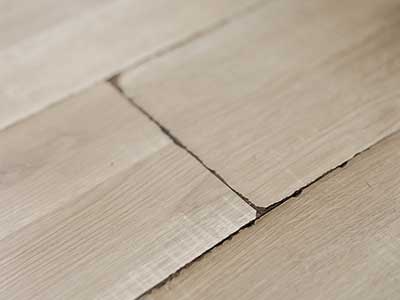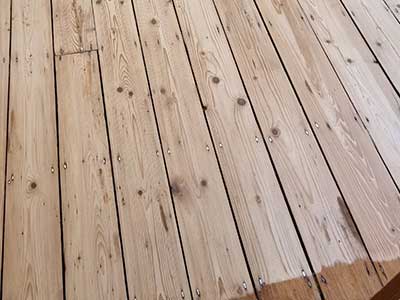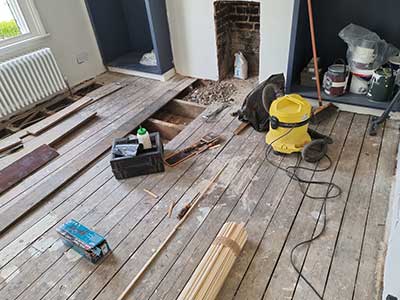Back to Wood Floor Fitting
Common Mistakes in Hardwood Floor Installation
 Whether you're a homeowner, a fellow contractor, or someone who simply appreciates the beauty of hardwood floors, this guide aims to equip you with the knowledge to detect and address installation problems promptly. Let's embark on this journey together to uphold the standard of excellence in hardwood flooring installations.
Whether you're a homeowner, a fellow contractor, or someone who simply appreciates the beauty of hardwood floors, this guide aims to equip you with the knowledge to detect and address installation problems promptly. Let's embark on this journey together to uphold the standard of excellence in hardwood flooring installations.
Uneven Floor Surface
An uneven wood floor surface can be a major inconvenience in any home or building. When walking on the floor, it may feel bumpy or sloped, making it uncomfortable and difficult to navigate. Additionally, furniture may wobble or not sit level on the floor, causing additional frustrations. Uneven surfaces can be caused by a variety of factors, including improper subfloor preparation or hasty installation.
If the subfloor was not properly leveled before the wooden floor was installed, it can result in a floor that is uneven and prone to shifting. Similarly, if the wood planks were quickly and carelessly installed, it can lead to gaps or inconsistencies in the floor surface. Ultimately, addressing an uneven wood floor surface requires identifying the root cause and taking appropriate steps to remedy the problem, such as leveling the subfloor or re-installing the wood planks.
Visible Gaps Between Planks
One common issue with wooden flooring is the visible gaps that often appear between adjacent planks. These gaps can be quite noticeable and can detract from the overall aesthetic appeal of the floor. Not only are these gaps unsightly, but they can also accumulate dust and debris, making it difficult to maintain the cleanliness of the floor. It can be quite frustrating to constantly have to sweep or vacuum these gaps to keep the floor looking clean.
There are a few reasons why these gaps may occur. One possibility is that the tongue-and-groove connections of the planks were poorly fitted, leaving gaps in between. Another reason could be that the floorboards were not properly acclimated before installation, causing them to expand or contract and create gaps. Regardless of the cause, it is important to address these gaps sooner rather than later to prevent further damage or deterioration of the floor.
Buckling or Warping of the Floorboards
Buckling or warping floorboards can create an uneven surface, posing a risk to the occupants of a space. This issue is often a result of excessive moisture exposure or improper installation. When floorboards are exposed to high levels of moisture, such as from spills or leaks, they can absorb the water and expand, causing them to lift or arch. This not only affects the appearance of the floor but also makes it unsafe to walk on. Inadequate acclimation of the floorboards before installation or the use of inappropriate fastening methods can also lead to warping.
If the floorboards were not properly acclimated to the environment where they were installed, they may expand or contract after installation, resulting in warping. Additionally, if the fastening methods used were not suitable for the specific type of floorboards, they may not be able to withstand the natural movement of the wood, causing it to warp over time. Regular maintenance and addressing any signs of buckling or warping promptly can help prevent further damage and ensure the longevity and safety of the floor.
Excessive Creaking or Squeaking
Excessive creaking or squeaking is a common problem in many households. When the floor produces loud noises when walked upon or weight is applied, it can be quite annoying and distracting. There are several reasons why this may occur. Loose nails, subfloor issues, or lack of proper fasteners can cause creaking. Over time, nails can become loose or damaged, resulting in movement and noise. In some cases, the subfloor may not have been properly installed or prepared, leading to instability and creaking.
Additionally, poor-quality materials used during construction or renovation can contribute to squeaking. For example, if the floorboards or underlayment are of low quality, they are more likely to produce noise when pressure is applied. Ultimately, addressing excessive creaking or squeaking requires identifying the underlying cause and taking the necessary steps to fix the problem, such as tightening loose nails, reinforcing the subfloor, or using higher-quality materials for future repairs or renovations.
Cupping or Crowning of the Floor
 Cupping or crowning of the floor refers to the curving of wooden boards in either a concave shape (cupping) or a convex shape (crowning). Cupping occurs when there is moisture infiltration from the bottom of the boards, causing them to swell and curve upwards in the centre. This can happen due to various reasons such as excessive moisture in the subfloor, plumbing leaks, or improper installation. On the other hand, crowning indicates moisture exposure from the top surface of the boards.
Cupping or crowning of the floor refers to the curving of wooden boards in either a concave shape (cupping) or a convex shape (crowning). Cupping occurs when there is moisture infiltration from the bottom of the boards, causing them to swell and curve upwards in the centre. This can happen due to various reasons such as excessive moisture in the subfloor, plumbing leaks, or improper installation. On the other hand, crowning indicates moisture exposure from the top surface of the boards.
This is often a result of poor humidity control in the environment, causing the boards to dry out and shrink in the centre, leading to a convex shape. Both cupping and crowning are signs of water damage and can cause significant issues with the floor's structural integrity. It is essential to identify the cause and address it promptly to prevent further damage and ensure the longevity of the flooring.
Nail or Fastener Popping
Nail or fastener popping is a common issue that occurs when nails or fasteners become visible on the surface as they push through the wood. This problem typically arises when fasteners are improperly placed or not adequately sunk. When nails or fasteners pop out, they can cause a range of problems. Firstly, they become an eyesore, affecting the overall aesthetics of the wood surface. Additionally, they can also pose safety hazards, as they can easily snag clothing or cause injuries to unsuspecting individuals.
Moreover, if left unaddressed, popping nails can lead to further damage. They can scratch or dent furniture and other objects that come into contact with them. Furthermore, the popping nails can interfere with foot traffic, causing an inconvenient and potentially dangerous situation. To prevent nail or fastener popping, it is important to make sure that fasteners are properly placed and adequately sunk into the wood. This will not only improve the appearance of the wood surfaces but also ensure the safety and longevity of the materials used.
Poorly Done or Inconsistent Staining
Poorly done or inconsistent staining can result in a floor that does not have a uniform appearance. One common issue is uneven colour distribution across the surface. Instead of a smooth and consistent hue, there may be patches or sections where the stain is significantly darker or lighter. This can be quite noticeable and can detract from the overall aesthetics of the floor. Another problem that can occur is the presence of streaks or blotches of darker or lighter spots. These streaks or blotches can be distracting and make the floor look uneven or splotchy.
One of the main causes of staining issues is inadequate sanding or improper application techniques. If the floor surface is not properly sanded or prepped before the stain is applied, it can result in uneven absorption of the stain, leading to inconsistent colouring. Additionally, if the stain is not applied correctly using the appropriate techniques, it may not penetrate evenly into the wood, causing uneven colouration. Therefore, it is essential to ensure proper sanding and application techniques are employed to avoid poorly done or inconsistent staining.
Finish Problems and Irregularities
Finish problems and irregularities can be quite frustrating and unsightly on any floor. One common issue is the presence of scratches, bubbles, or patches of uneven texture on the floor's finish. These imperfections can easily catch the eye and detract from the overall aesthetics of the space. Another problem that can occur is inconsistent sheen levels across the surface. This means that certain areas may appear dull while others shine, creating an unbalanced appearance.
These finish problems can arise due to various factors including poor application techniques, the use of low-quality finish products, or inadequate drying time. When the finish is applied incorrectly or with subpar materials, it can result in a poor-quality finish that is prone to these irregularities. Additionally, not allowing sufficient time for the finish to dry properly can also contribute to these issues. It is important to address these problems promptly as they can negatively impact the overall look and durability of the floor.
Loose or Lifting Floorboards
 Loose or lifting floorboards can be a common issue in older homes or those with poor construction practices. When some floorboards are not securely attached to the subfloor, they tend to move and create an unstable walking surface. This movement can not only be an annoyance but can also lead to further damage. Loose floorboards can cause other nearby boards to become loose, creating a domino effect of instability. Additionally, if left unaddressed, loose boards can allow moisture or pests to enter the subfloor, ultimately compromising the structural integrity of the floor.
Loose or lifting floorboards can be a common issue in older homes or those with poor construction practices. When some floorboards are not securely attached to the subfloor, they tend to move and create an unstable walking surface. This movement can not only be an annoyance but can also lead to further damage. Loose floorboards can cause other nearby boards to become loose, creating a domino effect of instability. Additionally, if left unaddressed, loose boards can allow moisture or pests to enter the subfloor, ultimately compromising the structural integrity of the floor.
The issue of loose or lifting floorboards often arises due to insufficient nails or incorrect fastening methods during the initial installation. Properly securing floorboards to the subfloor, such as using more nails or choosing the appropriate fasteners, can help prevent or alleviate this problem. Regularly inspecting and addressing any loose or lifting floorboards is essential for maintaining a safe and stable walking surface in a home.
Improper Subfloor Preparation
Improper subfloor preparation can have serious consequences for hardwood floor installations. One common issue is when the subfloor is not adequately leveled or cleaned before installation. This can result in an uneven surface, which can not only affect the aesthetics of the floor but also its integrity. An uneven subfloor can lead to squeaks and give the floor a bouncy or unstable feel. Another issue that can arise from inadequate subfloor preparation is the absence of a moisture barrier.
Without a proper moisture barrier, the hardwood floor is susceptible to cupping, warping, or even rot over time. Moisture can seep through the subfloor and impact the hardwood, causing irreversible damage and compromising its longevity. Therefore, it is crucial to ensure that the subfloor is properly leveled, cleaned, and adequately protected with a moisture barrier before installing a hardwood floor. By taking these necessary precautions, homeowners can avoid potential headaches and ensure the long-term durability of their hardwood flooring.
Worried about making costly mistakes during your hardwood floor installation? Let our experienced team handle it for you. We’ve seen (and fixed) it all—so you can avoid the common pitfalls and enjoy a flawless finish. Book a free site visit or contact us today for expert advice and professional fitting services.